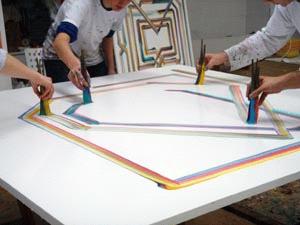Bernard Frize
dal 1/4/2005 al 28/5/2005
Segnalato da
1/4/2005
Bernard Frize
Galerie Emmanuel Perrotin, Paris
Faces et profils

At the gallery Emmanuel Perrotin, Bernard Frize is showing tree new series
of paintings. They sustain in a spectacular way the reflections which have
driven the artist for more than twenty years.
The merry easiness of Bernard Frize paintings seems to challenge any
attempt at describing them. When it comes to put pen on paper and convey
what takes hold us when beholding them, one has to order a mess of
impressions and take the risk of loosing the sense of their unity.
One set presents the weaving of four branches intertwined into a
braid.Contemporary mathematical literature studies this pattern (groups of
transforming braid and nods). In order to obtain a braid, one needs the
regular passing of alternating brunches one over the other. Among the
pictorial questions distinctively answered by Bernard Frize, is that,
which consists in showing this kind of alternation. In mathematical
publications, the answer is very simple: the branches are represented by
an unbroken black thread, which becomes intermittent when passing below
itself or another branch. One ventures that the authors have been fooling
around the design with countless attempts at redrawing, erasing, tracing
in order to achieve it. (In a similar process, the technique used by Vinci
or Durer in their interlaces has been erased.) In Bernard Frize's
paintings, everything is shown, nothing has been erased. One can follow
the passing of the brushes above previous lines thanks to the traces
superimposed and the blending of colours, which happens.
One can thus follow the tracing of a branch, its evolution and its
closing: one sees the starting point when the brush is heavy with colours
and the ending of the trace where it is most airy and frail. "It has to be
possible to see the slightest mark left by the brush, as though it were a
report". This however does not solve the challenge of representing an
interlace made of several branches. If each of them had been traced in a
row, one after the other, there wouldn't have been any interlaces to see.
No braid, no nod, no blending of colours. Only a mere superimposition of
branches. In order to achieve an intertwine, Bernard Frize picks up a
technique he invented a few years ago: four-hands painting. The artist
defines for himself and three assistants one's order of passage. Over the
horizontal canvas, they perform the order of the game. When contemplating
the pictures produced abiding by these rules, one cannot but imagine the
choreography, which presided over their execution.
Another set shows patterns of four branches tresses, but the tresses are
loose. One could describe them as if there were the previous tresses, but
a side view of them, not frontal one. These are loose interlaces: at the
two ends of the pattern, one sees the branches is edges, left unfastened.
One can reconstitute what their closing would be like by animating the
woobly branches: they would gather in a virtual nod before or behind the
canvas. This is another virtue of Bernard Frize' s paintings: they provoke
the beholder into mental experiences.
The colours of the two series are impossible to define. Each branch is
traced by several brushes held together and the neighbouring colours melt
lightly with a view to become totally impossible to distinguish precisely
just as they would be, had they been in some mathematical treatise.
Notwithstanding its virtuosity, BF painting is not about demonstration. It
remains a sensual experience, one "feels that it all happened in a shot,
obeying to a single gesture".
A third set proposes horizontal images composed of stitch: a row of
horizontal curls is intertwined with another row of curls below and so
forth. It is a simplified plait. Here again, the complexity lies in the
art of rendering this intertwine with painting. The order and tempo of the
passages below and above has to be visually respected, that is to say,
with Bernard Frize, in the order, which dictates the fabrication itself.
Here the colours, more vivid, turn into chained melting hues.
Bernard Frize ironically signals that: "A formal analysis of painting
should come to terms with explaining what is seen; this is at least the
meaning of the question, which is incessantly asked me: 'How is it
made?'." But the answer to this question cannot account for images, which
appear before our eyes. The knowledge that the patterns made of changing
colours are enhanced by several layers of white resin, does not, for
example, tell us much of the visual appeal these images convey. Their
allure is unfathomable.
In the theoretical debates, which have agitated painters for a century,
Bernard Frize holds an eminent position: the rigour of his methods and the
freedom of their execution endow him with the power of painting exploring
dimensions never suspected before.
Eric Duyckaerts
--contemporary
Tony Matelli
Fucked
Known for his hyper-real allegorical sculpture, Tony Matelli investigates the complexity of contemporary culture and calls into question societal mores so often taken for granted.
"Self-realization is the current societal dilemma, actually it always has been, we’ve just been distracted. With our current state of relative stability we find ourselves with out external distractions. Many of us are starting to look inward, and we are coming up empty.
I make work that speaks of the need and the frustration of trying to locate oneself within an already set world. My work frequently depicts things finding wayward means of survival. This is the truest way I know to depict the current psychological state among myself, my friends and acquaintances; the people I make work about, and the people I make work for."
Tony Matelli
Galerie Emmanuel Perrotin
76 rue de Turenne 75003 Paris
Opening hours: Tuesday to saturday, 11am to 7pm.



